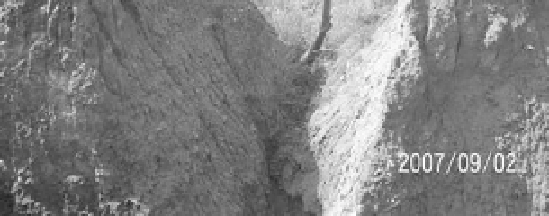Environmental Engineering Reference
In-Depth Information
River, is spectacular. With incision exceeding 10 m, landslides were generated on hillslopes due to both
modification of aquifer drainage and footslope destabilization by channel degradation. This example
illustrates negative effects on human activities, especially when landslides occur in urbanized areas
affecting roads and houses. The relation between landslide and riverbed incision will be discussed in
Chapter 4.
The most far-reaching influence of channel incision is soil erosion. In fact stream channel incision is
the essential cause of bank erosion, rill erosion, and slope erosion. Channel incision increases stream
slope, bank slope, and instability of watershed slope. The increased soil erosion and sediment yield may
cause a new cycle of fluvial processes of the river. The process may last for a century or a longer period
of time. Over history the Yellow River scoured the channel down to the bedrock in the middle reaches,
which reduced the base level of all tributaries from the Loess Plateau. Most of these tributaries have not
reached equilibrium and headward channel erosion, bank erosion, and gully erosion are still continuing
after centuries. Figure 3.43 shows the eroded gullies in the loess plateau and headward erosion.
Fig. 3.43
Eroded gullies in the Loess Plateau and headward erosion, which are essentially caused by channel
incision of rivers on the plateau
The Xiaojiang River in Yunnan was an incised river and experienced a high rate of bed incision
because its confluence with the Jinsha River was suddenly scoured down around a million years ago. The
incision propagated upstream and propagated into its tributaries. The Jiangjia Ravine is a tributary of
Xiaojiang River. The incision caused soil erosion in its watershed, which has become the most serious
erosion land in the Xiaojiang River basin. In a recent period the upper Jiangjia Ravine experienced an
accelerate incision, which caused gravitational erosion and a new cycle of slope soil erosion. Figure 3.44(a)
shows the incised upper Jiangjia Ravine. The ravine was incised down and there is no bed structure to
resist the incision because the lithology consists mainly of shale, which was broken due to tectonic
motion. Thus the lower part of the ravine banks is very steep. Serious gravitational erosion occurred, as
shown in Fig. 3.44(b). Bank failures and landslides occurred and destroyed the pine forest, which was
developed on the slope before the accelerated incision and the new cycle of erosion.
The direct and short-term impacts of channel incision are listed in Table 3.6, including damage to
human structures, and impacts on aquatic and riparian ecosystems. This review is not intended to be
comprehensive, rather examples are cited only to illustrate the trends summarized from the literature.



Search WWH ::

Custom Search